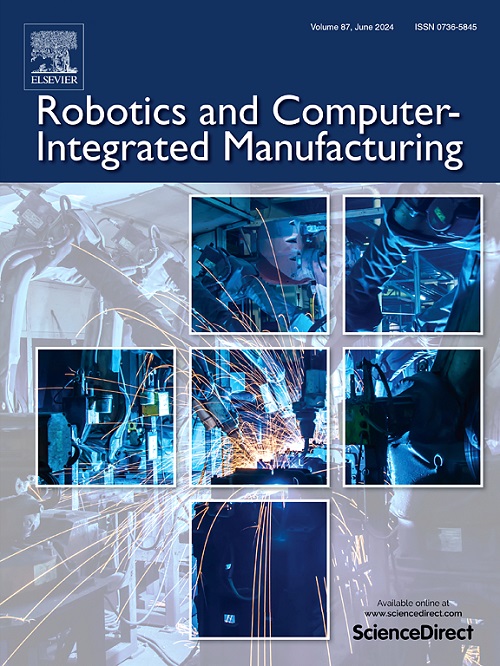非平稳制造系统的知识图谱构建与因果结构挖掘方法
IF 9.1
1区 计算机科学
Q1 COMPUTER SCIENCE, INTERDISCIPLINARY APPLICATIONS
引用次数: 0
摘要
知识图(KG)是一种利用图结构对多源异构数据进行管理并形成知识进行推理的方法。它已被广泛应用于制造系统中,促进了智能制造的发展。在非平稳制造系统中,单个元件的加工性能表现出可变性和动态波动。制造系统的重大动态和不确定性给KG的建模、构建和推理带来了巨大的挑战。为了克服这些挑战,本文提出了一种数字物理制造知识图(DPMKG)的构建和推理方法。首先,建立了基于本体的知识表示模型,将数字领域知识与物理领域性能波动描述相结合,建立了DPMKG的模式层;其次,提出了SysML模型驱动的构建管道,促进了数字和物理领域多源数据的关联和集成,从而建立了DPMKG的实例层。第三,提出了DPMKG的因果结构挖掘方法,以提高非平稳制造系统的分析推理能力。最后,以某航空发动机机壳加工系统为例,建立了DPMKG模型,并对工艺质量预测任务进行了推理。实例研究表明,所提出的DPMKG建模、构建和推理方法可以有效地描述和分析非平稳制造系统物理域的性能波动。通过集成数字和物理领域知识,可以有效地利用广泛的数据来生成用于推理的知识,从而促进非平稳制造系统的智能和精细化控制。本文章由计算机程序翻译,如有差异,请以英文原文为准。
A knowledge graph construction and causal structure mining approach for non-stationary manufacturing systems
Knowledge graph (KG) is a method for managing multi-source heterogeneous data and forming knowledge for reasoning using graph structure. It has been extensively utilized in manufacturing systems to promote the advancement of intelligent manufacturing. In non-stationary manufacturing systems, the machining performance of individual elements demonstrates variability and dynamic fluctuations. The significant dynamics and uncertainties of a manufacturing system bring great challenges to KG's modeling, construction, and reasoning. To overcome these challenges, this paper proposes a Digital-Physical Manufacturing Knowledge Graph (DPMKG) construction and reasoning method. Firstly, an ontology-based knowledge representation model is developed to facilitate the integration of digital domain knowledge with the description of physical domain performance fluctuations, thereby establishing the schema layer of DPMKG. Secondly, a SysML model-driven construction pipeline is proposed to facilitate the correlation and integration of multi-source data from both digital and physical domains, thereby establishing the instance layer of DPMKG. Thirdly, a causal structure mining method for DPMKG is developed to enhance the analytical and reasoning capabilities in non-stationary manufacturing systems. Finally, an aero-engine casing machining system is employed as a case study to establish the DPMKG, and reasoning is performed on the process quality prediction task. The case study reveals that the proposed DPMKG modeling, construction, and reasoning approach can effectively describe and analyze performance fluctuations in the physical domain of a non-stationary manufacturing system. By integrating digital and physical domain knowledge, the extensive data can be effectively leveraged to generate knowledge for reasoning, thereby facilitating intelligent and refined control of non-stationary manufacturing systems.
求助全文
通过发布文献求助,成功后即可免费获取论文全文。
去求助
来源期刊
CiteScore
24.10
自引率
13.50%
发文量
160
审稿时长
50 days
期刊介绍:
The journal, Robotics and Computer-Integrated Manufacturing, focuses on sharing research applications that contribute to the development of new or enhanced robotics, manufacturing technologies, and innovative manufacturing strategies that are relevant to industry. Papers that combine theory and experimental validation are preferred, while review papers on current robotics and manufacturing issues are also considered. However, papers on traditional machining processes, modeling and simulation, supply chain management, and resource optimization are generally not within the scope of the journal, as there are more appropriate journals for these topics. Similarly, papers that are overly theoretical or mathematical will be directed to other suitable journals. The journal welcomes original papers in areas such as industrial robotics, human-robot collaboration in manufacturing, cloud-based manufacturing, cyber-physical production systems, big data analytics in manufacturing, smart mechatronics, machine learning, adaptive and sustainable manufacturing, and other fields involving unique manufacturing technologies.

 求助内容:
求助内容: 应助结果提醒方式:
应助结果提醒方式:


